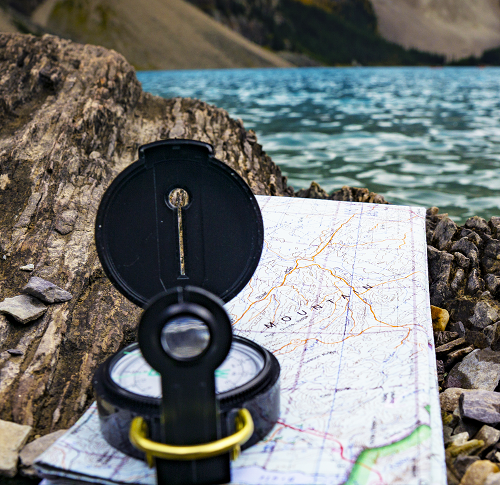Map Printing: 5 Benefits of Printing Maps on Synthetic Paper

estimated reading time: 5 minutes
Even in our digital world, where smartphone apps and GPS are
heavily relied upon for navigation, printed maps are still in demand. In fact,
the use of printed maps will likely remain well into the future because a
printed map has several advantages over a map displayed on a digital device.
For one thing, printed maps don't rely on batteries or a
broadcast signal to function. You can always count on a printed map to perform,
whether you find yourself lost on a road trip or in survival mode deep in the
wilderness.
In addition, a printed map provides a larger area to view, which contains more details than a digital map. This allows you to see more of the surrounding
area at one time. The small screen of a digital device might guide you from
point A to point B efficiently, but you lose awareness of the environment as a
whole. As a result, you could easily miss important aspects or things that might have been of
interest.
Also, many people just prefer the feel and function of a conventional
map that has been printed on paper. This is likely because paper maps can be folded or unfolded as needed
and can be easily written upon to highlight routes, mark locations, or add notes.

Printed Maps: Traditional Paper vs Synthetic Paper
Now that we've discussed some of the reasons why a printed
map might be preferred over its digital counterpart, let's compare the two most
popular types of paper used for creating printed maps - traditional paper and
synthetic paper.
For centuries, maps have been printed on traditional paper, which is made from the cellulose fibers found within the wood of trees.
Historically,
traditional paper has been a good choice for map projects because it accepts
ink well and folds neatly. It is also an inexpensive and readily available substrate
on which to print.
The only real drawback of using traditional paper for maps is
its lack of durability. Because it is fabricated from wood fibers that have
been pressed together, it can tear rather easily. Traditional paper also absorbs
moisture, which can quickly weaken the bond between the cellulose fibers. Once fully
saturated, the bond between the wood fibers begins to separate and the paper can
come apart.
Needless to say, traditional paper doesn't have all the qualities
needed for certain map projects, especially maps used in wet, damp, and humid environments
or under rugged outdoor conditions. This is the reason why synthetic paper has
gained popularity for map printing in recent years.
Synthetic paper is made from polymer-based resins. Despite
being made from inorganic substances, synthetic paper has an appearance very similar
to traditional paper. Also, synthetic paper can be printed and folded just as
well as traditional paper.
However, because synthetic paper is a plastic-like material,
it offers strength and durability that is far superior to traditional paper. As such, this innovative material
has become the preferred choice for a variety of map projects.

Below are 5 Benefits of Printing Maps on Synthetic Paper…
1. Strength and Durability
Unlike traditional paper that is made from organic wood
fibers, synthetic paper is made from polypropylene or polyester resins. The
molecular structure of these polymers gives synthetic paper tremendous strength and durability.
This enhanced toughness ensures that a printed map can withstand frequent
handling, as well as harsh outdoor conditions like strong winds, heavy precipitation,
or rugged terrain. Synthetic paper increases the reliability
and longevity of any map printed on it.
2. Resistance to Rips and Tears
One of the primary concerns of a traditional paper map is its
vulnerability to being ripped or torn, thus diminishing its usability and
shortening its life. Synthetic paper, on the other hand, offers excellent tear
resistance. This ensures that printed maps will remain intact, even during extreme
outdoor adventures such as canyoning or caving. By choosing synthetic paper for
your map project, the risk of damaging the map is greatly minimized.
3. Resistance to Moisture and Stains
When using a map outdoors, encountering moisture at some
point is virtually inevitable. Whether a sudden rain shower appears or the map falls
into a body of water, a map made from traditional
paper becomes weak when saturated and can quickly fall apart. However, synthetic paper is
impervious to water and most other liquids. Even if a synthetic paper map is
completely submerged, it won't incur any harm. Also, the smooth surface repels dirt,
oil, grease, and stains. Best of all, a map made from synthetic paper can be easily wiped
clean.
4. Sharper Resolution -
Printing maps on synthetic paper allows for high-resolution
results. The super smooth surface of synthetic paper reduces ink seepage and enhances
the clarity of the printing. By increasing the sharpness of the colors and details,
it is easier to interpret and navigate through the various locations displayed
on the map.
5. Environmentally Friendly -
As concerns for the environment increase, so does the need for
eco-friendly alternatives. Since the production of synthetic paper does not involve
the use of wood fibers, no trees need to be harvested. Also, synthetic paper is
completely recyclable for use in a variety of new applications. Plus, the
durability of synthetic paper means it is very long lasting, so maps and other
products made from it do not need to be replaced as often.

Are You Looking for Map Printing Services?
If you are looking for map printing services, be sure to get
in touch with Color Vision. We can print a wide variety of maps, on
synthetic or traditional paper stock.
Just give us a call at 800-543-6299 if you have any questions or want to discuss an upcoming project.
Or, if you already know your
specifications and are looking for a price, just fill out our Quote Request
form and we will be happy to email you a quote.
As always, we hope to hear from you and look
forward to assisting with any map printing need you may have!
Related Articles

Map Printing: 5 Benefits of Printing Maps on Synthetic Paper
Read This Article

Map Printing: Which Format is Better Suited for Your Project?
Read This Article